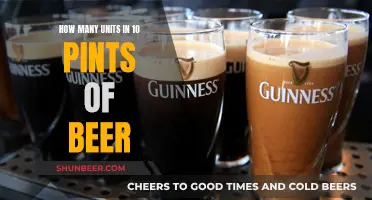
The pint is a unit of volume or capacity in the imperial and United States customary measurement systems. The British imperial pint is about 20% larger than the American pint. In the UK, Ireland, and most European countries, a pint of beer is 568ml, while in the US, it is 473ml. In some countries, like the Czech Republic, Austria, and Germany, beer is typically ordered in millilitres or litres, with 500ml being the closest measure to a pint.
| Characteristics | Values |
|---|---|
| Definition of a pint | A unit of volume or capacity in the imperial and United States customary measurement systems |
| Volume of a pint | 1/8th of a gallon |
| Volume of an imperial pint | 568ml |
| Volume of an American pint | 473ml |
| Countries that use the imperial pint | United Kingdom, Ireland, Canada, Australia, New Zealand, South Africa, and other Commonwealth nations |
| Countries that use the American pint | The United States |
| Countries that use other definitions of a pint | China, France, Germany, Belgium, the Netherlands, Norway, Sweden, Israel, South Korea, and some Spanish-speaking countries |
| Average alcohol content of a pint of beer | 20 grams or 25.4ml |
| Average sugar content of a pint of beer | 5 sugar cubes |
| Average time to eliminate a pint of beer from the body | 4 hours |
| Cheapest pint of beer | Caracas, Venezuela ($0.70) |
| Most expensive pint of beer | Dubai ($11.60) |
What You'll Learn

Pint glasses: different shapes and sizes
The pint is a unit of volume or capacity in both the imperial and United States customary measurement systems. The British imperial pint is about 20% larger than the American pint. The imperial pint is used in the United Kingdom and Ireland, and to a limited extent in Commonwealth nations. The American pint, on the other hand, is used in the United States and is also recognised in the UK and Ireland.
The standard American pint glass is heavy-bottomed with straight, tapered sides. Nicknamed the "shaker", it is the perfect size and shape to pair with a cocktail shaker for mixing drinks. The American pint glass is a popular, versatile, and affordable option for bars and restaurants. It can be used to serve any style of beer and is commonly customised with bar logos.
The Imperial pint, also known as an English pub glass or nonic pint, is the standard pint glass used in the UK. The nonic glass features a bulge near the lip of the glass, adding to its structural durability and making it less likely to be chipped. It also fits comfortably in the hand and stacks well. The Imperial pint is generally used as a multipurpose glass, but some say that the curvature of the glass is best suited to ales and stouts.
There are several other types of beer glasses commonly used, each with its own unique shape and characteristics. Here are some of the most popular ones:
- Pilsner glass: Tall, skinny, and slightly wider at the mouth, a pilsner glass showcases the sparkle, clarity, and bubbles of pilsners and other light beers. It also helps retain the beer's head, keeping the aromatics intact.
- Tulip glass: With a bulbous body and a flared lip, the tulip glass is designed to capture the head and promote the aroma and flavour of Belgian ales and other malty, hoppy beers.
- Goblet/Chalice glass: Goblet glasses have a large, head-retaining round bowl and a thick stem, while chalices tend to have thicker bowl walls. They are often decorative and are ideal for savoring hearty, heavy, dark beers.
- IPA glass: The distinctive IPA glass has a tall, slender, tapered bowl that concentrates and directs the hop aromatics to your nose. It also helps retain carbonation and keeps a frothy head.
- Stout glass: The stout glass is similar to the IPA glass but has a slightly wider bowl and a sharper curvature to deliver rich, toasted aromatics. It also features a shelf-like shape that encourages a cascade of sinking bubbles.
- Weizen glass: The weizen glass, or wheat beer glass, is tall and narrow, showcasing the colour of wheat beers. It also locks in the style's signature banana and clove aromas and provides space for a thick, fluffy head.
- Stange glass: The stange glass is narrow, straight, and cylindrical, similar to a champagne flute. It concentrates the soft hop and malt aromas and preserves carbonation, making it perfect for light, delicate beers.
- Beer mug: Beer mugs come in various shapes and sizes, but they all have a handle for easy grasping and clinking. They are classic pub glassware, perfect for beers with strong malty flavours like lagers, stouts, and porters.
Exploring Belgium's Diverse Beer Culture: A Tasty Overview
You may want to see also

How to order a pint in different countries
Ordering a pint of beer in a foreign country can be tricky if you don't speak the local language. Here's a guide on how to order a pint in different countries, so you can enjoy a cold, refreshing beer no matter where your travels take you.
Czech Republic
In the Czech Republic, you can order a pint by saying "Jedno pivo, prosím" (yid-noh pee-voh pro-seem).
France
To order a pint in France, ask for "Une bière s'il vous plaît" (ewn bee-ehr, see-vooh-pleh).
Germany
In Germany, "Ein Bier, bitte" (ighn beer, bit-uh) will get you a pint of beer.
Greece
For a pint in Greece, say "Mea bira parakalo" (mee-ah bee-rah para-kal-oh).
Hungary
In Hungary, ordering a pint is as simple as asking for "Egy pohár sört kérek" (edge poe-har short keh-reck).
India
To order a pint in India, say "Muhje ek beer chahiye" (moo-jeh ayk beer cha-hee-ye).
Indonesia
In Indonesia, you can request a pint by saying "Tolong satu bir" (toe-long sah-two bihr).
Italy
To get a pint in Italy, ask for "Una birra, per favore" (oo-na beer-rah, pair fa-vo-ray).
Japan
In Japan, "Nama biru kudasai" (nama beer-ooh koo-dah-sigh) will get you a nice cold pint.
South Korea
For a pint in South Korea, say "Meckjoo hanjan do jusayo" (mek-ju han-jan du joo-se-yoh).
Netherlands
To order a pint in the Netherlands, say "Ik wil graag een biertje" (ik vil khrahkh en beer-tyeh).
Poland
In Poland, "Poproszę piwo" (prohsheh pee-vo) will get you a delicious ice-cold pint.
Portugal
To order a pint in Portugal, ask for "Uma cerveja, por favor" (oo-mah sehr-vay-juh, poor pha-vohr).
Russia
In Russia, you can request a pint by saying "Manye pazaloosta butilku piva" (mah-nyeh, pa-zah-lu-sta, buh-tyl-ku pee-vah).
South Africa
To get a pint in South Africa, say "'n bier, asseblief" (uh beer ah-suh-bleef).
Spain
When ordering a pint in Spain, ask for "Una botella de cerveza, por favor" (oo-na boh-teh-yah de thair-vey-suh, pohr fah-bohr).
Sweden
In Sweden, "En öl, tack" (ahn url, tahck) will get you a pint of beer.
Thailand
For a pint in Thailand, say "Cyn mot li roo bia" (sin-muht lee roo bee-ah).
United Kingdom and Ireland
In the UK and Ireland, simply ask for "a pint" as they use the imperial pint measure.
United States
When ordering a pint in the US, keep in mind that they use a smaller liquid pint measure, so you might want to specify "an imperial pint" to get a larger serving.
Now you're equipped with the knowledge to order a pint in multiple languages! Cheers to that!
Beer Consumption: 5 Pints, Too Much?
You may want to see also

The price of a pint around the world
The price of a pint of beer varies significantly around the world, and even within countries, the cost can differ from city to city.
The most expensive pints
According to Deutsche Bank's "Mapping the World's Prices" series, the most expensive place in the world to buy a pint of beer is Dubai, where an average pint costs $12. New York City and San Francisco are close behind, with an average beer costing over $7. Oslo, Norway, is another expensive city for beer drinkers, with an average pint costing $10.30.
The cheapest pints
At the other end of the scale, you'll find the cheapest pints of beer in Caracas, Venezuela, where a pint costs just $0.70. Manila in the Philippines is another budget-friendly destination for beer lovers, with an average pint costing just $1.50. Other cities where you can find affordable beer include Prague in the Czech Republic ($1.60) and Bratislava, Slovakia ($2.22).
Other notable prices
In Hong Kong, China, you can expect to pay $10.86 for a pint, while Geneva in Switzerland isn't far behind at $10.77. Tel Aviv in Israel is also one of the more expensive cities for beer, with an average pint costing $9.53.
Ordering a pint in different countries
It's worth noting that the term "pint" isn't universally understood outside of the US and the UK. In many countries that use the metric system, a "pint" may refer to a different volume or be considered a cliche "tourist" thing to order. In these countries, it's generally better to order "a beer" and receive the standard size for that country or city. In some cases, you may need to specify a size, such as "large" or "small". Learning how to order a beer in the local language is always appreciated by bartenders and can make your drinking experience more enjoyable.
Fluid Ounces in an American Pint of Beer Explained
You may want to see also

How long does it take to eliminate a pint of beer from your system?
The time it takes to eliminate a pint of beer from your system depends on a variety of factors, including your age, sex, weight, metabolism, and how much you've eaten. As a general rule of thumb, it takes about one hour for your body to metabolise one unit of alcohol, which is about 10ml or 8g of pure alcohol. A pint of low-strength lager, beer or cider (3.6%) contains about two units, while a higher-strength pint (5.2%) contains about three units.
Therefore, a pint of low-strength lager will take about two hours to be eliminated from your system, while a higher-strength pint may take three hours. These are just estimates, and the actual time may vary depending on individual factors. For example, alcohol will affect a lighter person more than a heavier person, and it remains in a woman's system longer than a man's due to a woman's greater proportion of body fat. Younger people can also metabolise alcohol faster than older people.
Beer Strength: 3.2 vs 6, What's the Difference?
You may want to see also

How many grams of alcohol are in a pint?
The number of grams of alcohol in a pint depends on the type of pint and the type of beer. In the UK, a unit of alcohol is defined as 10ml or 8g of pure alcohol. In the US, a "standard" drink contains around 14 grams of alcohol.
A pint of standard-strength lager or ale with a 4.5% ABV contains 2.5 units of alcohol. Using the UK metric, that's 20 grams of alcohol. Using the US metric, it's 29.4 grams of alcohol.
In the United States, a pint of beer is 16 fluid ounces, or 473 millilitres. In the UK, a pint is 20 fluid ounces, or 568 millilitres.
The imperial pint is used in the United Kingdom and Ireland and to a limited extent in Commonwealth nations. In the United States, two kinds of pints are used: a liquid pint and a less common dry pint. Other former British colonies, such as Australia, South Africa and New Zealand, converted to the metric system in the 1960s and 1970s.
Calories in Beer: How Many in a Pint?
You may want to see also
Frequently asked questions
A pint is a unit of volume or capacity in the imperial and United States customary measurement systems. It is traditionally one-eighth of a gallon.
The volume of a pint varies depending on the country. In the UK, Ireland, and most European countries, a pint is 568ml. In the US, a pint is 473ml.
There are eight pints in a gallon.
A pint glass is a type of drinkware used to serve beer or cider. Common shapes include conical, nonic, jug glasses, and tulip glasses.







